Lovely, lovely lavender
-
Cultivated for thousands of years for its beauty, fragrance, and flavor, lavender is one of many Mediterranean plants that do well in the Bay Area. Once used in Egyptian perfumes and Roman baths, its name probably comes from the Latin verb “lavare,” meaning “to wash.” Lavender was introduced into England in the 1600s, where it was prized by royalty for use in teas and jams.
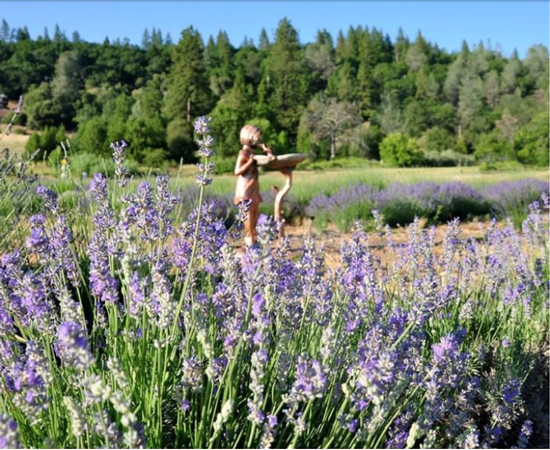 Lavender ‘Lavandula’ Photo: Bluestone Meadow Farm
Lavender ‘Lavandula’ Photo: Bluestone Meadow FarmLavender is an evergreen, woody perennial or subshrub with a multitude of garden uses, from borders and walkways to containers and mass plantings. It is part of the mint family, along with other hardy, drought-tolerant plants such as sage, rosemary and catmint.
Lavender is easy to grow, sun loving, and drought-tolerant. It resists most pests, including deer, yet it’s highly attractive to bees and butterflies. Flowers usually range from blue and lilac to deep purple, but there are some pink, white, and yellow shades as well.
Three main types of lavender
Although there are more than 400 varieties, there are three main types of lavender, varying in size, color, bloom time, and tolerance for heat and cold temperatures. Planting several different kinds of lavender can extend the bloom season and give your garden color from early spring into fall.
Non-English lavenders
These are the first blooming lavenders, with flowers appearing in early spring in warmer climates and often continuing through summer. The common names are imprecise and somewhat confusing.
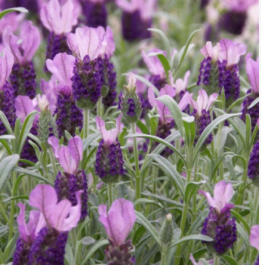 L. stoechas ‘Anouk’ Photo: GardenSoft
L. stoechas ‘Anouk’ Photo: GardenSoft
Spanish lavender, Lavandula stoechas, is also sometimes called French lavender because it grows well in France. It is low and wide, up to 2 feet tall and 3 feet across. It is heat and drought tolerant but somewhat frost tender. Foliage is needle-shaped and silvery, and flowers are recognizable for their large bracts, resembling butterfly wings. L. stoechas ‘Anouk’ and ‘Silver Anouk’ are hybrids.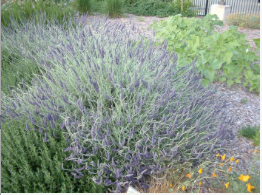 L. ginginsi ‘Goodwin Creek Grey’ Photo: GardenSoft
L. ginginsi ‘Goodwin Creek Grey’ Photo: GardenSoft
Also called French lavender is Lavandula dentata. It is quite vulnerable to frost, has toothed leaves, light purple flowers, and grows 2 to 3 feet tall and wide. L. ginginsi ‘Goodwin Creek Grey’ is a heartier hybrid and a cross between L. dentata and L. Lanata.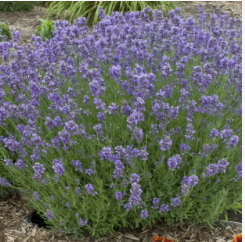 L. angustifolia ‘Munstead’ Photo: GardenSoft
L. angustifolia ‘Munstead’ Photo: GardenSoft
English lavenderThe next to bloom, from late spring to mid-summer, is English lavender, Lavandula angustifolia. The smallest of the lavenders, it is compact and dainty, ranging from 12 to 24 inches tall. Flowers may be intense blue or purple, and it is the most prized among lavenders for culinary use and the essential oils used in soaps and perfumes. English lavender is cold hardy but struggles with intense heat. ‘Munstead’ is one of the most heat-tolerant.
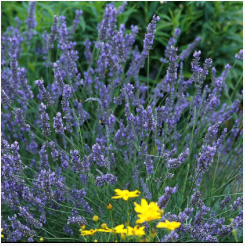 L. x intermedia ‘Grosso’ Photo: GardenSoft
L. x intermedia ‘Grosso’ Photo: GardenSoft
English hybridsLavandula x intermedia, also known as the lavandins, are the last to bloom. A cross between English (L. angustifolia) and Portuguese lavender (L. latifolia), lavandins are fast growing, heat and drought tolerant, and flower from mid to late summer. Sporting long, gray leaves, they are the tallest lavenders, often up to three feet tall and wide. ‘Provence’ and ‘Grosso’ are well-known varieties.
Lavender careAlthough unfussy and easy to grow, lavender has a few critical requirements: lots of sun, non-acidic soil (pH of 6 to 8), and excellent drainage. Heavy clay soils should be amended with coarse compost to improve drainage. Planting on slopes or berms will also help to improve drainage.
New plantings need consistent moisture for the first year or two but should never become soggy. Established plants are drought-tolerant but bloom best with some water. Fertilize lightly with compost or a slow-release fertilizer once a year in early spring. Too much fertilizer leads to excess foliage and fewer flowers.
After the second year, plants can be cut back by about a third in early spring to encourage new growth. This is especially helpful for lavandins, as they may sprawl and become woody if not cut back. Do not prune into the wood at the base of the plant, because it will not regrow. A second pruning after flowering, lightly shearing blossoms and stems, will encourage re-bloom.
Proper pruning of lavender is especially important given our increasingly fire-prone environment. Any plants that become old and woody and difficult to maintain should be removed and replaced.
Most lavender plants live for five to seven years, but properly tended, they may reward you with their beauty for years longer.
Original article by Doris Gates for the Marin Independent Journal
Edited for the Leaflet by Lisa MacCubbin





